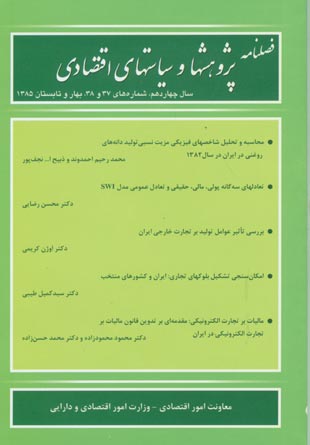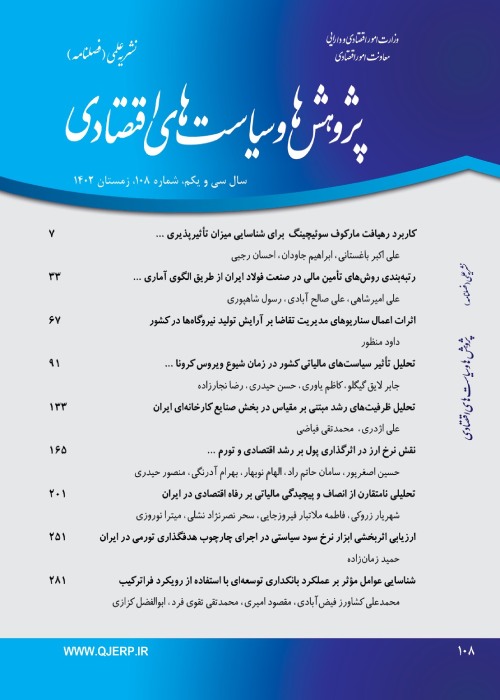فهرست مطالب

فصلنامه پژوهش ها و سیاست های اقتصادی
پیاپی 37-38 (بهار و تابستان 1385)
- 125 صفحه،
- تاریخ انتشار: 1385/05/10
- تعداد عناوین: 5
-
صفحه 5پایین بودن ضریب خودکفایی تامین روغن نباتی در ایران و ارزبری فراوان واردات روغن خام و کنجاله یکی از مشکلات عمده در اقتصاد کشور است که با شناسایی مناطق مستعد جهت کشت دانه های روغنی و برنامه ریزی صحیح در این زمینه می توان این ضریب را بهبود و مشکلات به وجود آمده را کاهش داد. مهم ترین شاخصهای قابل استفاده در خصوص شناخت مناطق مستعد و رتبه بندی آنها در تولید محصولات کشاورزی، شاخصهای مزیت نسبی است. در این مقاله جهت اولویت بندی استانها به منظور تولید دانه های روغنی (آفتابگردان روغنی، پنبه دانه، سویا و کلزا) از شاخصهای مزیت کارایی(EAI)، مزیت مقیاس (SAI) و میانگین هندسی این دو (AAI) در سال 1382 استفاده شده است. این شاخص ها شاخصهای فیزیکی مزیت نسبی بوده و براساس سهم عملکرد و سهم سطح زیرکشت محصول در استان نسبت به کل کشور محاسبه می شود. با توجه به نتایج حاصل از محاسبه شاخصها مناسب ترین استانها برای کشت پنبه دانه خراسان شمالی و اردبیل، برای آفتابگردان روغنی، گلستان و مرکزی و برای کلزا و سویا اردبیل است.
کلیدواژگان: مزیت نسبی، دانه های روغنی، مزیت کارایی، مزیت مقیاس -
تعادلهای سه گانه پولی، مالی، حقیقی و تعادل عمومی مدل SWIصفحه 17نظریه سی و تعادل والراس فقط برای یک اقتصاد تهاتری است. در یک اقتصاد مبادله ای و پولی نظریه سی و تعادل والراس نیاز به بازنگری دارد. در حقیقت با وارد کردن واسطه های پولی و مالی به عنوان عامل سوم، همراه با بازارهای خاص خود در نظریه و مدل تعادل عمومی، نظریه اقتصادی سنتی اصلاح می شود. پولی که با تبدیل شدن به دارایی مالی از فعالیت جاری اقتصادی خارج می شود و به صورت اعتبار و سرمایه مالی وارد این جریان می شود، ضمن آنکه بازارهای پولی و مالی را به فعالیت واقعی اقتصاد می افزاید، بر فرآیندهای پولی و مالی و در نتیجه ثروت و تولید تاثیرگذار است. در نتیجه متغیرهای پولی و مالی از ناحیه مخارج (سرمایه گذاری) و درآمد (پس انداز) متغیرهای حقیقی اقتصاد را تحت تاثیر قرار می دهد. مدلهای سنتی مثل IS-LM تاکنون نتوانسته است. این روابط چندگانه را به صورت کامل بیان کند. مدلی که در اینجا ارائه شده روابط مالی، پولی و حقیقی را به صورت نوینی ارائه کرده است.
کلیدواژگان: اتحاد سی، تعادل عمومی، بازارهای پولی و مالی، بخش حقیقی اقتصاد، مدل SWI -
صفحه 43در این مقاله به بررسی ترکیب عوامل تولید به لحاظ کاربر یا سرمایه بر بودن بر صادرات و واردات فعالیتهای مختلف اقتصاد ایران در سه مقطع زمانی 1370، 1376 و 1382 با استفاده از روش داده – ستانده محاسبه و برحسب قیمتهای ثابت ارائه شده است. فرضیه اساسی مطالعه حاضر این است که در بخشهای مختلف اقتصاد ایران اشتغال زایی صادرات نسبت به واردات بخشها در دوره زمانی مورد بررسی بالاتر است. یافته های این مطالعه نشان می دهد که از نظر به کارگیری عامل کار و سرمایه برای صادرات و واردات بخشها، فعالیتهای اقتصادی ایران بر اساس استفاده از مزیت نسبی عوامل تولید انجام شده است. واردات صنایعی که درصد بالایی از سهم واردات کشور را به خود اختصاص داده اند نظیر صنایع شیمیایی، ماشین آلات و تولید فلزات اساسی، جزو بخشهایی بوده اند که سرمایه بری نسبی صادرات آنها نسبت به واردات بیشتر بوده است. شدت سرمایه بری این صنایع در طول زمان روند نزولی داشته است. صنایعی که سهم بیشتری در صادرات غیرنفتی داشته اند نظیر صنایع چوب و محصولات چوبی، کشاورزی، حمل ونقل، صنایع نساجی و خدمات بازرگانی در زمره فعالیتهایی بوده اند که دارای نسبت سرمایه به نیروی کار پایین تری بوده یعنی نسبتا کاربر بوده اند.
کلیدواژگان: عوامل تولید، تجارت، اشتغال، صادرات، واردات -
صفحه 69یکپارچگی اقتصادی نوعی سیاست بازرگانی است که موجب کاهش یا حذف موانع و محدودیتهای تجاری تبعیض آمیز میان کشورهای عضو و هم بسته می شود. در واقع یکپارچگی اقتصادی زمانی صورت می گیرد که گروهی از کشورها، سیاست های بازرگانی مشترک را به نفع یکدیگر و در راستای افزایش توان تجاری خود مورد تصویب قرار می دهند که این هماهنگی سیاستهای تجاری می تواند بین دو یا بیشتر از دو کشور صورت گیرد. در حقیقت هر نوع توافقی که براساس آن کشورها سیاستهای پولی، مالی و تجاری خود را هماهنگ کنند به یکپارچگی اشاره دارد. مطالعه حاضر به بررسی اثر یکپارچگی تجاری بر جریان تجاری بین ایران و بلوکهای منتخب طی دوره زمانی 2003-1992 پرداخته و در این راستا از روش «داده های تابلویی» بهره گرفته است. براساس نتایج به دست آمده یکپارچگی تجاری بین ایران و اتحادیه اروپا، کشورهای حوزه خلیج فارس، کشورهای گروه D8 و کشورهای جنوب شرق آسیا موجب خلق تجارت می شود که در میان این اتحادیه ها، اتحادیه اروپا و اتحادیه کشورهای جنوب شرق آسیا از قدرت بیشتری برخوردار است.
کلیدواژگان: یکپارچگی تجاری، نظریه جاذبه، اتحادیه های تجاری، داده های تابلویی -
صفحه 85در تجارت الکترونیکی گزینش مکان، ماهیت دیجیتالی محصولات، ظهور دارایی های جدید، شیوه ثبت و پرداخت الکترونیکی مباحث مهمی هستند. نتایج تحقیقات نشان دهنده آن است که تجارت الکترونیکی تاثیر اندکی بر مالیات بر ثروت و بیشترین تاثیر را بر مالیات بر فروش دارد. بنگاه ها و مصرف کنندگان می توانند از این طریق،کالاهای دیجیتالی را بدون ثبت مبادله کنند. تجارت الکترونیکی با وجود قوانین بین المللی مشخص، مالیات بر واردات را بهبود می بخشد. درکوتاه مدت، معافیت بر تجارت الکترونیکی کاهش اندکی بر درآمدهای مالیاتی داشته ولی در بلندمدت هزینه های زیادی در بردارد. در این راستا انجام اقداماتی از سوی دولت جهت شناسایی شرکتها، مشاغل، ثبت فروشگاه های اینترنتی و استفاده از ابزارهای الکترونیکی در جمع آوری مالیاتها و قوانین بین المللی سبب افزایش درآمدها و گسترش تجارت می شود. از این رو لازم است به سادگی قوانین، توانایی اجرا، سازگاری، جلوگیری از وصول مالیات بیشتر، نبود تبعیض و امنیت مبادلات توجه شود.
کلیدواژگان: مالیات بندی الکترونیکی، کالاهای دیجیتالی، تجربه کشور ها
-
Page 5The low self-sufficiency coefficient of securing vegetable oil in Iran and the massive foreign exchange required for imports of raw oil and oil cake are regarded as one of the main problems in Iranian national economy. By recognizing appropriate regions for cultivating oil seeds and with a proper planning, this coefficient could be improved and the impact of the related adverse problems may be declined. Comparative advantage indices are regarded as the most important applied indices in order to recognize the appropriate regions and their ranking in the production of agricultural products. In this paper, for ranking provinces to produce oil seeds (oil sunflower, cotton seed, soya and colza), the Efficiency Advantage Index (EAI), Scale Advantage Indices (SAI) and the geometric mean of these indices in 1382 has been used. These indices are physical indices of the comparative advantage and are based on performance share and the percentage of the products in the province relative to the whole country. Regarding the obtained results of the calculated indices, the most appropriate provinces are as follow: Northern Khorasan and Ardebil for cotton seed, Golestan and Markazi for oil sunflower and Ardebil for colza and soya.Keywords: Comparative Advantage, Oil Seeds, Efficiency Advantage, Scale Advantage
-
The Triple Monetary, Fiscal and Real Equilibrium, and the General Equilibrium (SWI Model)Page 17Say’s law and Walrasian equilibrium are simply for a barter economy. In a monetary and trade economy, Say’s law and Walrasian equilibrium need to be revised. By introducing the financial and monetary intermediaries as a third factor together with their respective markets in the general equilibrium model, the traditional economic theory can be improved. The money which leaves the economic activity by becoming a financial asset enters this process as financial capital and credit. This would not only add the monetary and financial markets to the real economic activities, but also influences the monetary and financial processes, thereby affecting wealth and production. Monetary and fiscal variables therefore affect the real economic variables via expenditure (investment) and income (saving). The traditional models such as IS-LM have not yet been able to explain this interaction in a precise and comprehensive manner. The model presented here has described the fiscal, monetary and real economic relationships in a new format and approach.Keywords: Say's Law, General Equilibrium, Financial, Monetary Markets, Economic Real Section
-
Page 43This paper examines the impact of the factors of production regarding their labour-intensive or capital-intensive properties on exports and imports in Iran during the three time periods of 1370, 1376 and 1382 using input-output model based on constant prices. The principle hypothesis of this research work is that regarding the utilization of labour and capital in exports and imports sectors, Iranian economic activities are based on relative advantage of the factors of production. Importing industries which account a high percentage of Iranian imports such as chemical industries, manufacturing and basic metals are among those sectors which are relatively more capital intensive regarding their exports as compared with their imports. Those industries which have higher share in nonoil exports, such as wood industries and wood product, agriculture, transportation, textile and commercial services are among the economic activities with lower capital-labour ratio, i.e., are relatively labour-intensive.Keywords: Factors of Production, Foreign Trade, Relative Capital, Labour Intensive
-
Page 69Economic integration is considered as a policy by which trade barriers should be relaxed gradually or disappear fully among members of a trading block. Integration arrangements are implemented to make economic policies beneficial to members in order to strengthen their economic relations. In principle, integration refers to unified monetary, financial and trade policies that countries of an economic union have agreed upon. Applying the panel data model to the gravity theory, this paper examines the effects of trade integration on trade flows between Iran and selected economic blocks over the period of 1992-2003. The results obtained imply that trade integration between Iran and the economic blocks like the European Union (EU), PGCC, D8 and East Asian countries can lead to trade creation, while the trade intensities of the EU-Iran and East Asia-Iran are more pronounced than those of the others.Keywords: Trade Integration, Gravity Theory, Trade Blocks, Panel Data
-
Page 85Taxation of E-Commerce (EC) is one of the main challenges of Governments in the future. Traditional methods for taxation cannot respond in EC environment, because of the special features of EC such as the existence of digital goods, new kinds of assets, electronic payment, etc. Results indicate that EC has little effects on wealth tax and is most effective on the selling tax. Firms and consumers can exchange digital goods without registration. EC can improve import tax with transparent international law. Tax exemption causes little decline in government revenues in the short term, whereas its cost will be very large in the long-run. Governments should try to identify and register E-Corporations, E-Shops, E-Employment, and collect EC taxation. Governments should also consider simplicity, implementation and consistency of rules in E-Commerce taxation and try to announce criteria such as economic basics, special character of EC, discrimination principles and transaction security.Keywords: E, Commerce Taxation, Digital Goods, Countries Experiences


